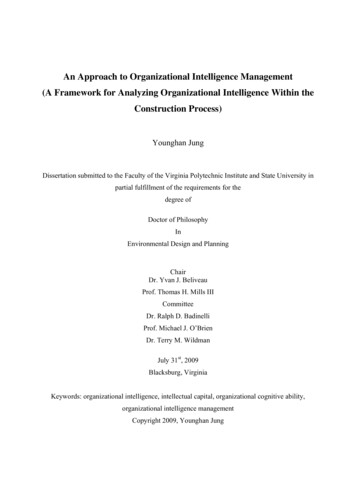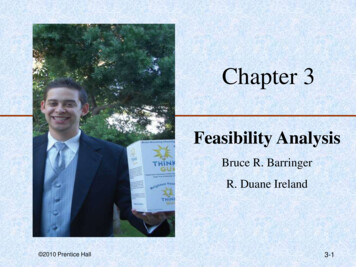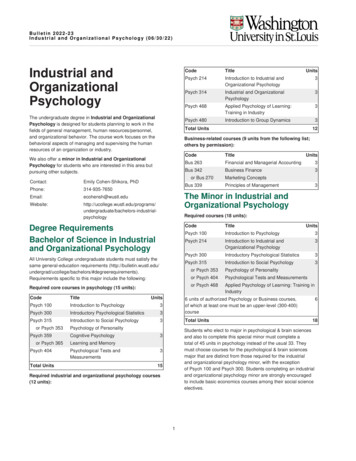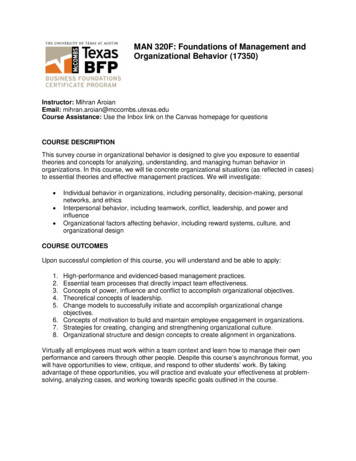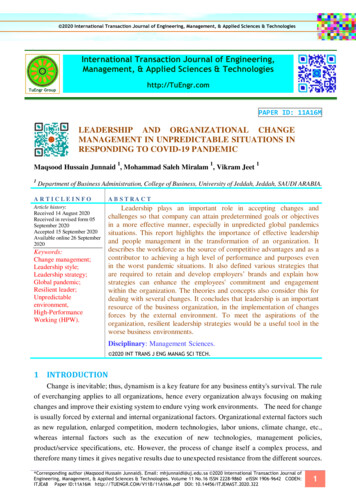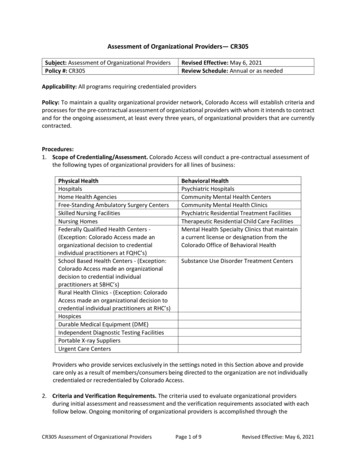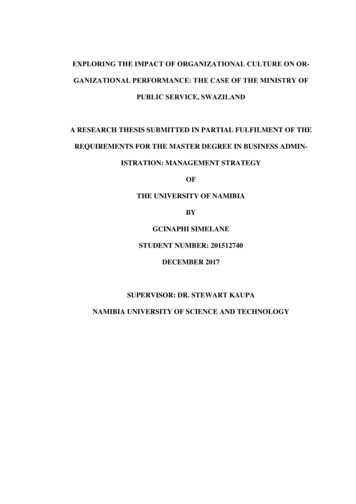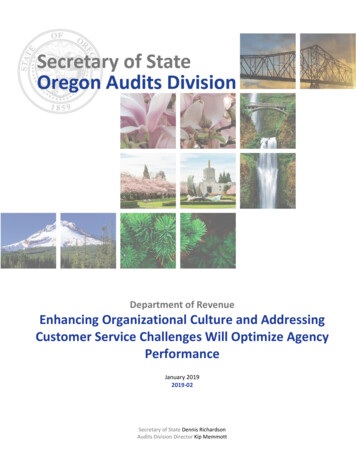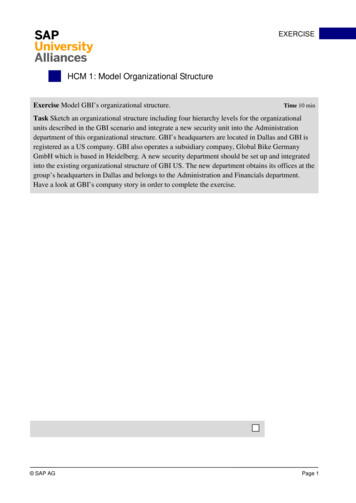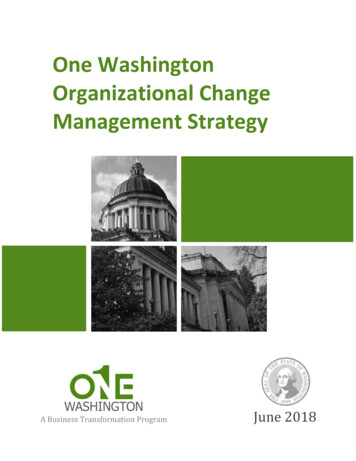
Transcription
One WashingtonOrganizational ChangeManagement StrategyOne WashingtonOrganizational Change Management StrategyA Business Transformation ProgramJune 20181
A Business Transformation ProgramTable of Contents1 Strategy Overview . 61.1Purpose . 61.2Key Question . 61.3Key Considerations and Assumptions . 61.4Executive Summary . 72 Change Management Overview . 82.1Change Management Core Concept . 82.2Scope . 82.3Transformation Change Management . 82.4ERP and BI Implementation Change Management . 82.4.1On-Premises/Best-of-Breed Implementation Change Management . 92.4.2SaaS Implementation Change Management . 92.4.3Agile Change Management . 92.5Change Model . 102.6Change Commitment Curve . 112.7Culture: Change Considerations . 132.7.1Culture: Change Considerations for Agile . 132.7.22016 Employee Engagement Survey . 142.7.3October-November 2017 Stakeholder Interview Insights . 142.8Change Behaviors . 142.9Creating Change Capability for the State of Washington . 152.10Change Management Approach for One Washington . 163 Stakeholder Identification and Engagement . 193.1Change Championship . 193.1.1Role of Leadership. 193.1.2One Washington Leadership Development . 193.1.3Leadership Transition Planning . 193.2Stakeholder Definition. 203.3Stakeholder Identification . 202
A Business Transformation Program3.4Agency and stakeholder engagement . 203.5Stakeholder Groups (by business area) . 213.6Change Effect on Stakeholder Groups . 233.6.1Approach . 233.6.2Assessment Considerations for On-Premises/Best-of-Breed ERP and BI Implementations. 233.6.3Assessment Considerations for SaaS (Finance and Procurement ERP and BI solution) . 233.6.4Feedback Cycles . 243.6.5High-Level Timeline . 244 Communication Strategy . 264.1Overview. 264.1.1Mission . 264.1.2Goals and Objectives. 264.2Communication Strategy . 264.3Scope . 274.3.1Context . 274.3.2Guiding Principles . 284.3.3Stages of Communications . 284.3.4Communication Channels . 314.3.5Audiences . 324.3.6The Role of Leadership in Communications . 334.3.7Communication Cascading . 334.3.8Communication Distribution Lists. 334.3.9Communication Roles and Responsibilities . 334.3.10 Communications High-Level Timeline . 354.3.11 Communications Feedback . 364.3.12 Success . 364.4Communication Plan. 364.4.1Communication Plan Template . 364.4.2Communication Plan Stakeholders . 374.4.3Communication Plan Dependencies . 374.4.4Communication Plan Management . 373
A Business Transformation Program5 Training. 375.1Training Requirements for Competitive Procurement cycles . 385.2Training Approach . 385.2.1SaaS Training Considerations . 395.3Training Development. 395.4Training Environment and Training Spaces . 395.5Learning Management System (LMS) . 405.6Training Delivery . 405.6.15.7On-Premises/Best-of-Breed/SaaS Training Delivery . 40High-Level Timelines . 426 Business User Engagement and Readiness. 436.1Approach . 436.2Governance . 436.3Transformation Advisory Committees . 436.4Transformation Network . 436.5Invite Vendors to Show Solution Capabilities (Market Research and Demos) . 456.6Business User Readiness . 456.7Measurement of OCM Success . 456.7.1Objectives . 456.7.2Benefits. 456.7.3Measurement Tool . 456.7.4Measurement Report . 466.8Business User Readiness Timeline . 477 One Washington Transformation Team . 487.1Roles and Responsibilities . 508 Closing Statement . 529 Appendix. 539.1Agile Barriers and Challenges . 539.2Challenges Experienced Adopting and Scaling Agile . 549.3Stakeholder Interviews October-November 2017 . 559.4Strategic Partner’s Change Model Compared to Prosci’s ADKAR . 569.4.1Prosci’s ADKAR with the Change Commitment Curve . 564
A Business Transformation Program9.5Change Effect Assessment Sample . 579.6Business User Readiness Tracker Sample . 5910 Key Terms/Glossary . 60Note: To promote clarity, the state’s enterprise-level administrative business domains aredifferentiated from agency-level domains, where possible, by means of capitalization. Forexample, Finance, Procurement, HR/Payroll and Budget refer to enterprise businessdomains. When referencing agency-level domains, or general business functions, thesedomains read as finance, procurement, HR/payroll and budget.5
A Business Transformation Program1Strategy Overview1.1Purpose1.2Key Question1.3Key Considerations and AssumptionsOrganizational change management (OCM) focuses effort on business“Change management needs to come intransformation. The One Washington change management strategyearly.”refreshes the change management approach developed as part of the-Agency Deputy Director2014 Business Case. The strategy sets the foundation for key OCMactivities which will support the One Washington program during a multiyear implementation. The strategy defines what change initiatives will look like and how we will work together tonavigate business transformation, with special emphasis on the OCM communications strategy.The strategy addresses the following question:What are the methods and approaches the One Washington program will develop to manage, communicate andenable the enterprise organizational change needed to successfully transform business processes and adopt amodern enterprise system for Finance, Procurement, HR/Payroll, and Budget as well as a Business Intelligencecapability.The strategy takes into consideration the following: The 2014 Business Case change management approach developed from the outcomes of theOrganizational Readiness Assessment. Enterprise organizational readiness was evaluated as of May 5,2014. High-level stakeholder analysis conducted in October-November 2017 that included interviews of 22agencies. Agencies and individuals interviewed are in Appendix 9.3. Resources to support One Washington’s OCM activities are included in sections 4 and 5 of the ProgramBlueprint. The estimate is calculated at 18% of total program costs. An overview of the proposed changemanagement team organization and roles can be found in section 7.o The strategy includes business transformation and enterprise resource planning (ERP) and BIchange management for the period of 01/2018 – 06/2026 The strategy will be updated and expanded to a more detailed change management plan as actual ERP andBI software solutions are identified. Current timelines for in scope systems:o Finance & Procurement: 11/2019 – 07/2023 – 07/2026 Wave 1 (Initial Deployment): 11/2019 – 07/2021 Wave 2 (Full Deployment): 01/2022 – 07/2022 Wave 3 (Expanded Functionality): 07/2022 – 07/2023o Budget: 07/2024 – 01/2026o HR/Payroll: 07/2024 – 01/2026o Business Intelligence (aligns to each of the ERP deployments): 11/2019 – 01/2026 This strategy assumes legislative support and funding to complete the Program.6
A Business Transformation Program1.4Executive SummaryChange management ensures that the right resources and processes are in place so that an organization effectivelytransitions to the desired future state and at the planned pace. The strategy provides the approach to changemanagement overall and for each of the Program’s major phases. The strategy has been developed withconsideration given to: Transformation of business processes.Implementation of software solutions (including on-premises, best-of-breed, Software as a Service - SaaS).Impacts of Washington’s enterprise environment and culture (including the history of past enterprisetransformation programs), and the desired behaviors to achieve change commitment.Influence of other factors that could impact change adoption (like leadership transitions and the degree ofagency change capability) for the duration of the Program.The strategy is based on data derived from the 2014 Business Case and OCM practices for complex multi-yeartransformations. It also includes the approach for improving readiness levels across the organization and fosteringtransformation adoption through: Stakeholder identification and engagementCommunicationsTrainingBusiness user engagement and business readinessThe goal of the strategy is to follow an established change model and approach to bring One Washingtontransformation stakeholders along the change journey.A change commitment curve (explained in section 2.6) illustrates the process of change commitment and adoption tofulfill the objectives of the Program.Dynamic OCM strategy: Based on feedback, the One Washington Transformation team will review and refineapplicable aspects of the OCM strategy as the effort proceeds.Objectives of the One Washington program will be achieved when end users have adopted the new systems andbusiness processes in a sustained demonstration of commitment.7
A Business Transformation Program2Change Management Overview2.1Change Management Core ConceptChange management ensures that the right resources and processes are in place so that an organization is able toeffectively transition to the desired future state and at the planned pace. This is achieved by: Being proactive and responsive to stakeholdersAnticipating and addressing potential impacts of the changeAnticipating and addressing potential resistance to changePlanning for and guiding the changeEnabling the target audience of the change to perform in the future statePlanning to sustain new ways of working and for continuous improvement in the desired future stateKey factors for the success of the One Washington change program: Developing change capability and change leadership Using OCM approaches for the Program, business transformation and ERP and BI. This includes onpremises and SaaS implementations Leveraging an established change model: the Accenture model (see Appendix 9.4 forcomparison/complement to Prosci model) Achieving change commitment Changing state culture and behaviors Using one change approach across the ProgramEach of the above factors are detailed further in this document.2.2ScopeOne Washington is a comprehensive business transformation program to modernize and improve the state ofWashington’s aging administrative systems and related business processes common across state government. TheOCM strategy focuses on both the enterprise partners’ transformation readiness and adoption level as well as theERP implementation itself. The effort will transform the state’s Finance, Procurement, HR/Payroll, Budget and BIsystems.2.3Transformation Change ManagementThe Program’s strategy supports the business transformation initiatives that will complement the implementation ofnew enterprise and business intelligence systems. These initiatives are discussed in more detail in section 3.2-3.3 ofthe Blueprint. The initiatives planned for FY19 are: Assess Procurement Organizational StrategyAssess Finance Organizational Strategy and Readiness ActivitiesProgram Management and Communications with the Authorizing EnvironmentThe Program will use the change model and change approach detailed in sections 2.5 and 2.10. The Program alsoconsiders the need for change leadership, culture change and behavior change (sections 3.1, 2.7, and 2.8respectively) to ensure consistency in approach to and navigation of state enterprise change.2.4ERP and BI Implementation Change ManagementChange Management is about the successful planning, managing, executing and adopting of ERP and BI systems byall levels of an organization. One Washington has applied structure and thought to change management and remains8
A Business Transformation Programflexible in its approach to guiding stakeholders to the ultimate objective of change commitment and adoption of newERP and BI systems. One Washington will follow a unified/SaaS approach for the Finance/Procurement/BIimplementation and will consider a unified/SaaS approach for implementation planning for Budget/BI and HR/Payroll/BI.2.4.1On-Premises/Best-of-Breed Implementation Change ManagementTraditional on-premises/best-of-breed implementations usually take a waterfall approach, with theimplementation geared toward a one-time delivery in production, also known as a big bang approach.Typically, most of the efforts in this type of implementation are prior to go-live and change managementfocuses on preparing the organization before go-live. The intended end users do not get the opportunity totouch or interact with the system until training (sometimes not until go-live) and must wait for a future phase tocollect new business capabilities to enhance the system.2.4.2SaaS Implementation Change ManagementFor SaaS implementations, the intent is to develop and enhance specific business capabilities in the preimplementation cycle. The result is an accelerated system deployment and earlier end user first contact(including prototyping and model office experiences). The change management effort shifts to place morefocus on showcasing the solution and allowing for user interaction prior to go-live, and by providing asustainable method of input for enhancements after launch.The SaaS solution for Finance and Procurement will take an approach to change management that is basedon Agile development principles.2.4.3Agile Change ManagementWith Agile development, the focus is to rapidly deploy a minimally viable product and then iteratively update itbased on early and frequent end user feedback. Because the nature and frequency of change activities differswith an Agile approach, and considering the magnitude of enterprise engagement, OCM will play a critical role.Figure 1 highlights the opportunities and challenges that the Program will focus on for SaaS implementations:9
A Business Transformation Program Create an enterprise culture of change capability. Create solutionshowcases and improvement initiatives. Implement continuouseducation and coaching, especially for leadership (includingCulture and Behaviormiddle management). Connect the One Washington programteam directly to business users throughout the enterprise toassist with their transition in their daily work.Leadership and Engage and train leadership first. Involve leadership as sponsorsand advocates and co-owners of change, keeping in mind theGovernanceoverall business transformation journey of the state enterprise. Solicit and act upon stakeholder input to create and sustain astrong, connected and effective Transformation Network /readiness network and/or user advocate group for changeTransformation Networkcommunications, training and organizational support.Collaboration Build cross-trained roles, dissolve One Washington silos and cocreate material with a high-level of business involvement.Members of the One Washington Transformation team workingside by side with One Washington functional and technicalteams.Figure 1: Agile Change Management Opportunities and Challenges.2.5Change ModelThe One Washington change management strategy is based on the Accenture change model (shown below inFigure 2.) This change model addresses four key dimensions of the change journey: Navigating changeLeading changeProviding tools to enable changeFacilitating ownership of the changeThis change model is complementary to the Prosci approach that some state agencies and departments havealready adopted. Appendix 9.4 provides further detail around the Accenture change model compared to Prosci’sADKAR model.10
A Business Transformation ProgramMain ActivitiesMain Activities Program managementframework (directionand pace of change) Models/methodologies Measurement strategies Technical/Businessarchictecture Set change objectivesand prioritiesNavigationWhat managementmechanisms willhelp OneWashingtonoptimize itsinvestment?LeadershipHow can we helpagency leaderseffectivelychampion change? Establish shared executivevision and communicate itto stakeholders Develop a LeadershipSponsorship Program Provide leadership withcoaching/facilitaiton Set expectations duringchangeOwnershipMain ActivitiesEnablement Design the organization/jobs* Revise workflows/procedures Redesign physicalenvironment* Design New/Modifiedjobs* Training and performancesupportHow do we givestakeholders thetools and supportto be successfull?How do we helpstakeholders feelpart of the changevs. victims ofchange?Main Activities Plan communications andinvolvement activties Educate impactedpersonnel on the changeprocess Develop local actionteams and facilitateimplementation Deliver focused benefits*Figure 2: Accenture Change Model.*Activities from the 2014 Business Case – Not in ScopeIn the Navigation dimension, the OCM framework is developed to include change objectives, priorities andmeasurement approaches. The Leadership dimension includes the development of a sponsorship program, theestablishment and communication of a shared executive vision, and setting expectations for the change process. TheEnablement dimension defines communication, training and other related performance management andorganizational design requirements. Lastly, the Ownership dimension is where those impacted by the change exhibitcommitment to the new target state through various involvement activities.One Washington will provide agencies with early direction and guidance regarding redesign of organizations,physical environments and jobs/roles. Individual agencies will be responsible to plan and perform agency-levelchanges, as these are not part of the role of One Washington.2.6Change Commitment CurveStakeholders’ commitment to the change is a critical dependency for enterprise success. The change journey forstakeholders is visualized in the change commitment curve (see Figure 3 below).The change commitment curve shows the distinct stages that stakeholders pass on their journey to change adoption:awareness, understanding, buy-in and commitment. With effective change management, stakeholders will navigateand support the change. Without OCM, users may oppose the change, waver in their support of the change, or movethrough the stages of change adoption at a slower pace than the rest of the state enterprise.11
A Business Transformation ProgramAs illustrated by Figure 3, stakeholder groups move at an anticipated pace: Sponsors move up the curve at a quicker pace and are more likely to support the change sooner because oftheir key position in initiating, acquiring funding and building a governance structure for the transformationeffort.Transformation Agents will have a focal role in disseminating information from sponsors and the OneWashington program to their agencies and departments. Given their Program knowledge and involvement,we would expect them to move up the curve quicker than an end user.End users will advance up the curve at the slowest rate because they are not involved in the day-to-dayevents of the transformation effort.The change model can be mapped to the change commitment curve to indicate the activities that should beperformed at each stage to help users progress to the next stage.Goal: Follow the change approach to bring individual users of the new systems successfully through the changecommitment curve to arrive at a state of change commitment.Figure 3: The Change Commitment Curve with Emphasis onthe Appropriate Change Model Quadrants for Each Change Stage.Successfully managing the four dimensions of the change model will ensure commitment for the change andincrease the ability of One Washington and enterprise partners to sustain and build upon that change. The focus andimportance of each of the change model’s four dimensions and the related change activities vary during the changelifecycle. For example:12
A Business Transformation ProgramTo build Awareness, One Washington will utilize multiple communication tools such as meetings, emailsand videos to build broad awareness of the change – when it’s happening, why it’s happening and how it’shappening. Change Navigation is the structure in place through which communications can happen.To build Understanding, One Washington will focus on employee engagement and championship(Leadership functions), as well as two-way communications vehicles such as a Transformation AgentNetwork and advisory committees. Communications will be aimed at building an understanding of how thechange impacts peoples’ work.To build Buy-In, One Washington will collaborate with enterprise partners to develop and provide in-depthtraining and on-the-job support to impacted employees. This is Enablement.To build Commitment, One Washington will develop sponsorship at the agency-level through two-wayvehicles and additional agency-specific training. This is Ownership. Generally, with proper OCM, stakeholder support for change increases over time. However, when OCM techniquesare not implemented, end users do not progress on this curve and must face the alternative. These alternatives aresh
The Program's strategy supports the business transformation initiatives that will complement the implementation of new enterprise and business intelligence systems. These initiatives are discussed in more detail in section 3.2-3.3 of the Blueprint. The initiatives planned for FY19 are: Assess Procurement Organizational Strategy
![Change Management Process For [Project Name] - West Virginia](/img/32/change-20management-20process-2003-2022-202012.jpg)
